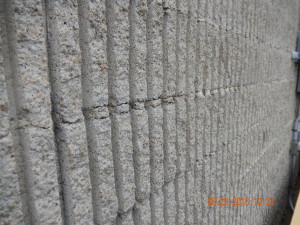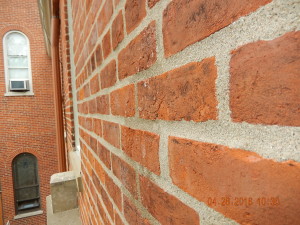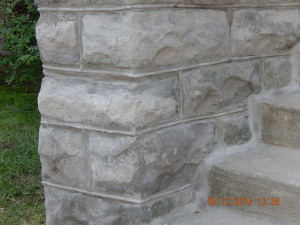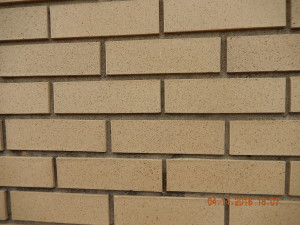
Poorly Compressed Joint
The type and style of the masonry mortar joints can be a deciding factor in the performance of your masonry when it comes to protecting your structure from water penetration. The profile of the mortar joint is created when the jointer strikes against the surface of the mortar before the joint has set. We will highlight some of the most common types in this brief article.
When selecting a joint type, it is important to consider both the desired architectural appearance and the weather resistance. Raked joints or other styles that leave ledges of the brick exposed can allow water/snow/ice to collect. Certain mortar styles which are merely filled and then scraped can produce a situation where the mortar never actually gets compressed into the joint which can lead to premature deterioration and moisture intrusion. Here are the various types of mortar joints to consider:

Concave Joint
Concave Joint: The concave joint is the most common joint that is used, as it is also known as the best joint for preventing water penetration. Tooling works the mortar tight into the joints, which produces better weather resistance.
V Joint: The V Joint does not protect from water as well as the concave joint because of its geometry. If it isn’t tooled correctly, water can accumulate in the joint. Similar to the concave joint, tooling works the mortar tight and can help to prevent water penetration if done correctly.
Weathered Joint: The weather joint is used to emphasize horizontal joints. The weathered joint helps shed water from the joint, however it is possible that water can run across the underside of the brick and get through if the mortar is not adhered tightly or if shrinkage cracks develop in the bond line.
Flush Joint: The flush joint is typically used when a wall is going to be plastered-over or when the joints need to be hidden under paint. In order to be weather resistant, this joint will take a little more work and attention. If not given the proper care, water can sit on top of the joint if it sticks out from the brick. It is also difficult to maintain a consistent and sufficient bond to the brick because the mortar is not compressed into the joint with the striking tool.
Squeezed Joint: The squeezed joint is commonly seen in indoor architecture or outdoor fences. It provides a rustic and high texture look, but poses a threat for moisture intrusion because it has three exposed sides exposed to the weather. This can lead to premature deterioration and thus moisture intrusion.

Beaded Joint
Beaded Joint: Similar to the squeezed joint, the beaded joint is not typically recommended for exterior building walls due to its exposed ledge. This joint is commonly seen in stone foundation walls as an architectural feature.
Raked Joint: The raked joint is another joint not recommended for exterior use because its ledge may allow water/snow/ice to sit on top of the brick. Due to the fact that the mortar sits back from the face of the brick, there is less cover between the face of the mortar joint and the top of the brick unit where the cores exist. Saturated mortar joints can allow water to enter the cores and permeate throughout the wall.
Struck Joint: The struck joint is used to emphasize horizontal joints. It is not recommended for exterior building walls because water can get through on the lower edge.

Raked Joint
No matter the joint, proper tooling will increase the water and weather resistance of the wall. When undertaking a repointing project, you are faced with the opportunity to reinstall the mortar with a different joint profile. A concave profile is typically desired in repointing projects because it provides the best opportunity to compress the mortar and to shield moisture. However, consideration should be given to the aesthetic intent and historic significance of the project.
It is important to note that each type of structure may require a slightly different process of joint tooling. Regardless of the type of joint being installed, it is essential that the striking sequence is consistent and performed at the proper time in the curing process. It is extremely important that a contractor knows the proper methods and the advantages and disadvantages of each joint type before proceeding with any repointing project.
If you need assistance with the masonry restoration of a structure, contact us at https://triscosystems.com/masonry-restoration/.
Resources: http://www.imiweb.org/imi_toolkit/pdf/ProperMortarJointTooling.pdf
http://www.qualityblock.com/joints.html
http://www.archtoolbox.com/materials-systems/masonry/mortarjoints.html
